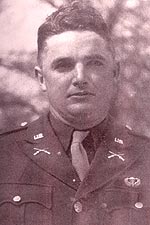I recently finished Stephen Ambrose’s Citizen Soldiers about World War II. It’s an interesting read throughout, but my absolute favorite story comes from the introduction. Ambrose describes the Lieutenant Waverly Wray of Company D, 505th Parachute Infantry Regiment, 82nd Airborne Division, commanded by Colonel Ben Vandervoot.

Lt. Waverly Wray
After jumping into Normandy, he began crawling through the sunken lanes to reconnoiter the German positions surrounding them. He came upon a group of eight German officers surrounding a radio — officers who turned out to be leading the counterattack. Wray jumped through the hedgerow and ordered them to surrender.
Seven instinctively raised their hands. The eighth tried to pull a pistol from his holster; Wray shot him instantly, between the eyes. Two Germans in a slit trench 100 meters to Wray’s rear fired bursts from their Schmeisser machine pistols at him. Bullets cut through his jacket; one cut off half of his right ear.
Wray dropped to his knee and began shooting the other seven officers, one at a time as they attempted to run away. When he had used up his clip, Wray jumped into a ditch, put another clip into his M-1, and dropped the German soldiers with the Schmeissers with one shot each.
Wray made his way back to the company area to report on what he had seen. At the command post he came in with blood down his jacket, a big chunk of his ear gone, holes in his clothing. “Who’s got more grenades?” he demanded.
…
Vandervoot later recalled that when he saw the blood on Wray’s jacket and the missing half-ear, he had remarked, “They’ve been getting kind of close to you, haven’t they Waverly?”
With just a trace of a grin, Wray had replied, “Not as close as I’ve been getting to them, Sir.”
Ambrose’s Band of Brothers (on which the HBO series of the same name was based) is more compelling overall, but because it tells the story primarily of a single company of paratroopers it necessarily offers a limited view of the war. Citizen Soldiers gives a more complete overview, but naturally at the cost of some finer detail. Clearly the only reasonable plan is to read both.
The picture of Lt. Wray comes from The U.S. Airborne During WW II, which came up in a Google search for Wray’s name, and which I now must absolutely explore in greater depth.
